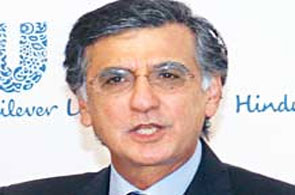 | « Back to article | Print this article |
Analysts, as well as investors of Hindustan Unilever Ltd, the country's largest fast-moving consumer goods company, were pleasantly surprised as the firm reported double-digit growth in revenue, as well as profit, for the fourth quarter. Harish Manwani, HUL's chairman, responded to questions from Viveat Susan Pinto on how his company managed to buck the trend after struggling for much of the financial year ended March 31. Excerpts:
What were the key contributors to growth in the fourth quarter?
 There are quarters when you will see growth and there are quarters when you will not see phenomenal growth. But the full-year numbers are a better indicator of what's happening with us than more immediate triggers on a quarter-on-quarter basis. When you have a 16 per cent top line growth that adds Rs 3,300 crore to net sales, with an underlying volume growth of seven per cent and a margin improvement of 80 basis points, that does speak a lot and remember we have achieved this in a difficult environment.
There are quarters when you will see growth and there are quarters when you will not see phenomenal growth. But the full-year numbers are a better indicator of what's happening with us than more immediate triggers on a quarter-on-quarter basis. When you have a 16 per cent top line growth that adds Rs 3,300 crore to net sales, with an underlying volume growth of seven per cent and a margin improvement of 80 basis points, that does speak a lot and remember we have achieved this in a difficult environment.
How are you doing in what you have described as categories of the future at a time when discretionary spends are clearly slowing down?
These are small segments at the moment, which have the potential to become big as you go forward. Within personal products, for instance, the segments of the future account for Rs 1,000 crore at the moment. But does that mean that these categories cannot grow as we go forward? I don't think categories such as skin lightening or liquid hand or body wash or fabric conditioners in laundry cannot become big as we go forward.
Look at the way, for instance, tea bags have grown in India in the last few years. Who would have thought it would explode the way it has? But it has as income and aspiration levels have grown in the country. It’s therefore important for us to keep investing, both from a short-term as well as long-term point of view.
Both CSD (canteen-store-departments) and modern trade as distribution channels have seen a slowdown in the last few quarters. Does that then put pressure on you to identify new channels of distribution?
How existing channels will perform depends to a large extent on how the environment around is. Modern trade, which contributes about 14-15 per cent of our business, has seen an impact mainly because of the categories that are pushed there, which are discretionary in nature. The profile of consumers in modern trade is different from a consumer who walks into traditional trade. This lent itself to discretionary categories.
In the current environment, the growth from modern trade has been lower in comparision to previous quarters. CSD, on the other hand, contributes about seven per cent to our overall business. There was a slowdown till the September quarter of the 2012-13 fiscal. But in the December and March quarters, growth is back on track.
As far as identifying new channels of distribution are concerned, that is an ongoing process. For instance, e-commerce, out-of-home and the Horeca (hotels, restaurants, cafes) segment are distribution channels of the future. Of this, we have pushed out-of-home in our ice-cream business with our Swirls parlours. This will be stepped up as we go forward.